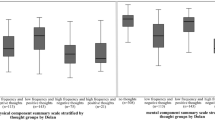Abstract
Purpose
Patient reporting of type 2 diabetes symptoms in a questionnaire with a 7-day recall period was expected to be different from symptom reports using a 7-day diary with repeated 24-h recall based on cognitive theory of memory processes and prior literature. This study compared these two types of recall in patients diagnosed with type 2 diabetes (T2D).
Methods
One hundred and forty adults with T2D completed a daily diary for 7 days containing 9 T2D-related symptom and impact items. On day 7, patients completed the same items with a 7-day recall period. We examined the concordance of 7-day recall with summary descriptors of the daily reports and compared the scores and the discriminant ability of 7-day recall and mean of daily reports.
Results
Seven-day recall was most concordant with the mean of daily reports. The average difference in scores was small (range 0.22–0.77 on 11-point scale) and less than 0.5 standard deviations. For some items, the difference was positively associated with the variation in daily reports. The discriminant ability was comparable.
Conclusions
In this study population, a questionnaire with 7-day recall provided information consistent with a daily diary measure of the average week-long experience of T2D symptoms and impacts.
Similar content being viewed by others
Abbreviations
- CCC:
-
Concordance correlation coefficient
- DSC-R:
-
Diabetes symptom checklist-revised
- FDA:
-
Food and Drug Administration
- HbA1c:
-
Glycated hemoglobin
- PRO:
-
Patient-reported outcome
- SF-36v2 Acute:
-
Short-form 36 health survey, version 2 Acute
References
Revicki, D. A., Osoba, D., Fairclough, D., Barofsky, I., Berzon, R., Leidy, N. K., et al. (2000). Recommendations on health-related quality of life research to support labeling and promotional claims in the United States. Quality of Life Research, 9(8), 887–900.
FDA. (2009). Patient reported outcome (PRO) measures: Use in medical product development to support labeling claims. Federal Register, 74(235), 65132–65133.
Stull, D. E., Leidy, N. K., Parasuraman, B., & Chassany, O. (2009). Optimal recall periods for patient-reported outcomes: Challenges and potential solutions. Current Medical Research and Opinion, 25(4), 929–942.
Hufford, M. R., & Shiffman, S. (2003). Assessment methods for patient-reported outcomes. Disease Management and Health Outcomes, 11(2), 77–86.
Homma, Y., Ando, T., Yoshida, M., Kageyama, S., Takei, M., Kimoto, K., et al. (2002). Voiding and incontinence frequencies: Variability of diary data and required diary length. Neurourology and Urodynamics, 21(3), 204–209.
Kenton, K., Fitzgerald, M. P., & Brubaker, L. (2006). What is a clinician to do-believe the patient or her urinary diary? Journal of Urology, 176(2), 633–635. (discussion 5).
Elser, D. M., Fantl, J. A., & McClish, D. K. (1995). Comparison of “subjective” and “objective” measures of severity of urinary incontinence in women. Program for Women Research Group. Neurourology and Urodynamics, 14(4), 311–316.
Richardson, M. T., Ainsworth, B. E., Jacobs, D. R., & Leon, A. S. (2001). Validation of the Stanford 7-day recall to assess habitual physical activity. Annals of Epidemiology, 11(2), 145–153.
Stel, V. S., Smit, J. H., Pluijm, S. M., Visser, M., Deeg, D. J., & Lips, P. (2004). Comparison of the LASA Physical Activity Questionnaire with a 7-day diary and pedometer. Journal of Clinical Epidemiology, 57(3), 252–258.
Gmel, G., & Daeppen, J. B. (2007). Recall bias for seven-day recall measurement of alcohol consumption among emergency department patients: Implications for case-crossover designs. Journal of Studies on Alcohol and Drugs, 68(2), 303–310.
Hilton, M. E. (1989). A comparison of a prospective diary and two summary recall techniques for recording alcohol consumption. British Journal of Addiction, 84(9), 1085–1092.
Stone, A. A., Broderick, J. E., Kaell, A. T., DelesPaul, P. A., & Porter, L. E. (2000). Does the peak-end phenomenon observed in laboratory pain studies apply to real-world pain in rheumatoid arthritics? The Journal of Pain, 1(3), 212–217.
Stone, A. A., Broderick, J. E., Shiffman, S. S., & Schwartz, J. E. (2004). Understanding recall of weekly pain from a momentary assessment perspective: Absolute agreement, between- and within-person consistency, and judged change in weekly pain. Pain, 107(1–2), 61–69.
Stone, A. A., Schwartz, J. E., Broderick, J. E., & Shiffman, S. S. (2005). Variability of momentary pain predicts recall of weekly pain: A consequence of the peak (or salience) memory heuristic. Personality and Social Psychology Bulletin, 31(10), 1340–1346.
Grootenhuis, P. A., Snoek, F. J., Heine, R. J., & Bouter, L. M. (1994). Development of a type 2 diabetes symptom checklist: A measure of symptom severity. Diabetic Medicine, 11(3), 253–261.
Ware, J. E., Jr., Kosinski, M., & Dewey, J. E. (2000). How to score version 2 of the SF-36 health survey. Lincoln, RI: Quality Metric, Incorporated.
Ware, J. E, Jr., Snow, K. K., Kosinski, M., & Gandek, B. (1993). SF-36 Health survey manual and interpretation guide. Boston, MA: New England Medical Center, The Health Institute.
American Diabetes Association. (2009). Standards of medical care in diabetes–2009. Diabetes Care, 32(Suppl 1), S13–S61.
Lin, L. I. (1989). A concordance correlation coefficient to evaluate reproducibility. Biometrics, 45(1), 255–268.
Deyo, R. A., Diehr, P., & Patrick, D. L. (1991). Reproducibility and responsiveness of health status measures. Statistics and strategies for evaluation. Controlled Clinical Trials, 12(4 Suppl), 142S–158S.
Bennett, A. V., Patrick, D. L., Lymp, J. F., Edwards, T. C., & Goss, C. H. (2010). Comparison of 7-day and repeated 24-hour recall of symptoms of cystic fibrosis (in press). doi:10.1016/j.jcf.2010.08.008.
Acknowledgments
We would like to thank Mona Martin RN MPA, Health Research Associates, Inc, for guidance in data collection, Shravanthi Gandra PhD MBA, Amgen, Inc, for her early participation in this study, and Denise Globe PhD and Xing-yue Huang PhD, Amgen Inc, for their contributions to planning the data collection. The data were made available through a study with multiple aims sponsored by Amgen, Inc. in a contract with Health Research Associates, Inc and Donald Patrick. Chiun-Fang Chiou is an employee of Amgen.
Author information
Authors and Affiliations
Corresponding author
Rights and permissions
About this article
Cite this article
Bennett, A.V., Patrick, D.L., Bushnell, D.M. et al. Comparison of 7-day and repeated 24-h recall of type 2 diabetes. Qual Life Res 20, 769–777 (2011). https://doi.org/10.1007/s11136-010-9791-5
Accepted:
Published:
Issue Date:
DOI: https://doi.org/10.1007/s11136-010-9791-5




